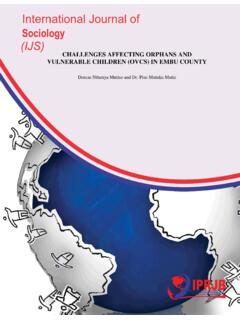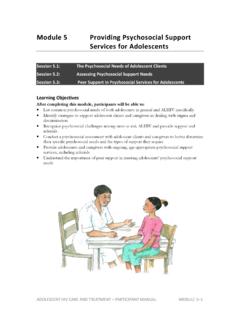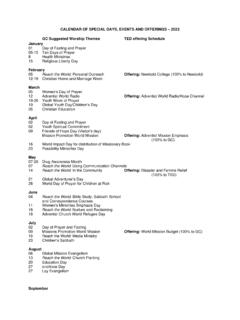Transcription of FEDERAL REPUBLIC OF NIGERIA 2017-2021
1 FEDERAL REPUBLIC OF NIGERIAN ational HIV and AIDS Strategic Plan 2017-2021 FOREWORDT raditionally the development of HIV/AIDS strategic plans in NIGERIA has followed a top down approach principally due to the FEDERAL nature of governance and perceived capacity deficiency at sub-national levels. This approach has led to products that were non-responsive to the states' epidemic status, capacity and available resources. Thus, most state SSPs in the past were inadequately implemented due to poor local ownership and resourcing and seldom guided implementation. The development of the National Strategic Plan (NSP) 2017-2021 was a robust and collaborative process involving all the relevant stakeholders and with a bottom- up approach. The process involved strategic plans at subnational and national level that were evidence driven and promoted ownership at all levels, synergy of efforts among the different partners and built on gains made so far in the national HIV response.
2 The vision of the NSP 2017-2021 is An AIDS-free NIGERIA , with zero new infection, zero AIDS-related discrimination and stigma, with a broad goal to Fast-track the national response towards ending AIDS in NIGERIA by 2030 . In line with the UNAIDS investment framework, the NSP 2017-2021 targets five thematic areas: (i) Prevention of HIV among General and Key Populations; (ii) HIV Testing Services; (iii) Elimination of Mother-to-Child transmission of HIV (eMTCT); (iv) HIV Treatment; and, (v) Care, Support and Adherence. The NSP also recognizes the role played by a number of cross-cutting issues and programme enablers (gender and human rights, health systems and community systems strengthening & service integration, coordination and institutional arrangement, policy, advocacy and resource mobilization, monitoring and evaluation and leadership, ownership and sustainability) that are critical to achievement of the vision, goal, objectives and targets outlined recognizes and acknowledges the technical and financial support of the FEDERAL Government of NIGERIA and our donors and partners in the development of the NSP 2017-2021 .
3 Civil Society, PLHIV and the states also played an important role and this is appreciated. The FEDERAL Government of NIGERIA led by NACA remains committed to our collective vision of an AIDS-free NIGERIA , with zero new infections and zero AIDS related discrimination and stigma. It is hoped that the relevant stakeholders will use the NSP 2017-2021 to guide planning and implementation of programs, interventions and activities so that our set goal, objectives and targets would have been achieved five years from now. Dr. Sani Aliyu Director GeneralNACAiiiACKNOWLEDGEMENTSThe National Agency for the Control of AIDS (NACA), wishes to appreciate His Excellency, the President of the FEDERAL REPUBLIC of NIGERIA , Muhammadu Buhari, GCFR, for the Leadership and support provided to develop this very important document called the National Strategic Plan (NSP) 2017 supportive role of the Secretary to the Government of the Federation, His Excellency Mr.
4 Mustapha Boss, as well as that of the Honourable Minister of Health, Professor Isaac. F. Adewole in epitomizing the vision and intent of the President geared towards ridding NIGERIA of the scourge of HIV/AIDS is highly visionary leadership of the Director- General of NACA, Dr Sani Aliyu and his Directors in ensuring access to much needed resources for the development of this document is appreciated. It is worthy to mention the support from the Country Offices of UNAIDS, WHO, UNICEF and Women in document was developed in an all-inclusive process with contributions from key sectors of the National HIV/AIDS response. The adit to this was the National HIV/AIDS Strategic Framework (2017 2021). The support garnered from our partners; Civil Society Networks especially NEPWHAN, CiSHAN, ASHWAN, APYN; Ministries and Agencies, SACAs and other key interest groups too numerous to itemise is duly acknowledged and profound appreciation also goes to the lead and costing consultants Professor Segun Fatusi, and Mr.
5 Emeka Nsofor. Your passion, dedication, and commitment to contributing to the attainment of an HIV/AIDS free NIGERIA is the Technical staff of both the National Agency for the Control of AIDS (NACA) and the FEDERAL ministry of Health- National HIV/AIDS and STI Control Programme (NASCP), who contributed enormously to the success of this document is acknowledged. The staff of the Department of Policy and Strategy NACA deserve special commendation for their insightful technical input, coordination, and management of the NSP development process. Dr. Chukwugozie Ujam, Oluwaseun Oshagbami, Ms. Priscilla Odangla, Ms. Joy Ezenekwe and support staff are all dearly appreciation goes to God Almighty for the privilege and seeing this Ogundipe MPHD irector, Policy & StrategyNACADec. 2017iiiAcronyms and Abbreviations AIDS Acquired Immune Deficiency Syndrome ANC Ante-natal care ART Antiretroviral Therapy ARV Antiretrovirals BBFSW BCC Brothel-Based Female Sex Worker(s)
6 Behavior Change Communication CBOs Community-Based Organizations CiSNHAN Civil Society Network for HIV/AIDS in NIGERIA CPT Co-trimoxazole Preventive Therapy CSOs Civil Society Organizations CSS Community Systems Strengthening CTX Co-trimoxazole DfID United Kingdom Department for International Development DHIS District Health Information System DOTS Directly Observed Treatment Short Course eMTCT Elimination of Mother-to-Child Transmission of HIV ENR EID Enhancing National Response to HIV and AIDS in NIGERIA Early Infant Diagnosis of HIV FBOs Faith-Based Organizations FCT FEDERAL Capital Territory FGoN FEDERAL Government of NIGERIA FLHE Family Life and HIV Education FMoH FEDERAL Ministry of Health FMWA & SD FEDERAL Ministry of Women Affairs and Social Development GBV GFATM Gender Based Violence Global Fund to fight HIV/AIDS, TB and Malaria GoN Government of NIGERIA HAD HIV/AIDS Division HAF HIV/AIDS Fund HCT HIV Counseling and Testing HIV Human Immunodeficiency Virus HSS Health Systems Strengthening HTS HIV Testing Services IBBSS Integrated Biological and Behavioral Sentinel Surveys IDPs International Development Partners IDU Injection Drug Users IEC Information, Education, Communication IMNCH Integrated Maternal, Newborn.
7 And Child Health IPs Implementing Partners JMTR Joint Mid-Term Review LACAs Local Action Committee on AIDS M&E Monitoring and Evaluation MDGs Millennium Development Goals MDR-TB Multi-Drug Resistant TB MPPI Minimum Prevention Package Intervention MIPA MSM Meaningful Involvement of People Living with HIV and AIDS Men who have Sex with Men MTCT Mother-to-child transmission of HIV NACA National Agency for the Control of AIDS ivNACS Nutritional Assessment, Counselling and Support NARHS National AIDS and Reproductive Health Surveys NASA National AIDS Spending Assessment NASCP National AIDS/STI Control Programme NBBFSW NBTS Non-Brothel-Based Female Sex Worker(s) National Blood Transfusion Service NDHS NIGERIA Demographic and Health Survey NGOs Non-Governmental Organizations NHSSS National HIV Sero-prevalence Sentinel Survey NPHCDA National Primary Health Care Development Agency NSF National Strategic Framework NSP National Strategic Plan NTBLCP National TB and Leprosy Control Program OIs Opportunistic Infections OVC orphans and vulnerable Children PABA People Affected By HIV/AIDS PCRP Presidential Comprehensive Response Plan PEP PEPFAR Post-exposure Prophylaxis President s Emergency Plan for AIDS Relief PHC Primary Health Care PHDP PLWHIV Positive Health, Dignity and Prevention People Living with HIV PMTCT Prevention of Mother to Child Transmission of HIV PrEP Pre-exposure Prophylaxis PWID RMNCAH SACAs SBCC People Who Inject Drugs Reproductive.
8 Maternal, Newborn, Child and Adolescent Health State Action Committees on AIDS/State Agency for the Control of AIDS Strategic Behavioural Change Communication SDPs Service Delivery Points SKM Strategic Knowledge and Management SMEDAN Small and Medium Enterprises Development Agency of NIGERIA SMoH State Ministry of Health SRH Sexual and Reproductive System STIs Sexually Transmitted Infections TasP Treatment as Prevention TB Tuberculosis TOR Terms of Reference TTIs Transfusion Transmittable Infections TWG Technical Working Group UN Women United Nations Entity for Gender Equality and the Empowerment of Women UNAIDS United Nations Joint Program on HIV/AIDS UNDP United Nations Development Programme UNFPA United Nations Population Fund UNGASS United Nations General Assembly Special Session UNICEF United Nations
9 Children s Fund USAID United States Agency for International Development USG United States Government VC vulnerable Children VCA WHO vulnerable Children and Adolescents World Health Organization vExecutive SummaryNigeria has the second highest burden of Human Immunodeficiency Virus (HIV) infection in the world, with about million people infected. NIGERIA contributed 9% of the people living with HIV, 10% of new HIV infections, and 14% of HIV-related deaths in the world in 2013. To address her high HIV burden, NIGERIA needs to institute a sustained and effective national response to prevent new infections and ensure the health and well-being of those infected and affected by HIV. The National HIV/AIDS Strategic Framework and Plan provide the backbone of such national response; they serve as a crucial platform for uniting stakeholders towards achieving the national HIV control goals, and tools for mobilising the required resources to that National HIV and AIDS Strategic Framework (NSF) 2017-2021 and National HIV and AIDS Strategic Plan (NSP) 2017-2021 were developed through a highly participatory and consultative process that involved a wide cross-section of stakeholders; these strategic documents succeed the National HIV and AIDS Strategic Framework 2010-2015 and the National HIV and AIDS Strategic Plan 2010-2015.
10 Vision of the National Strategic PlanThe vision of the NSP is An AIDS-free NIGERIA , with zero new infection, zero AIDS-related discrimination and stigma Goal of the National Strategic PlanThe goal of the National Strategic Plan is to Fast-track the national response towards ending AIDS in NIGERIA by 2030 Thematic Areas and Cross-Cutting IssuesThe National Strategic Plan has five thematic areas: (i) Prevention of HIV among General and Key Populations; (ii) HIV Testing Services; (iii) Elimination of Mother-to-Child transmission of HIV (eMTCT); (iv) HIV Treatment; and, (v) Care, Support and thematic areas are underpinned by a number of cross-cutting issues and programme enablers: (i) Gender and human rights; (ii) Health systems and community systems strengthening, and service integration; (iii) Coordination and institutional arrangement; (iv) Policy, advocacy and resource mobilization; (v) Monitoring and evaluation; and, (vi) Leadership, ownership and Area 1: Prevention of HIV among General and Key PopulationsStrategic Objective: To significantly reduce the incidence of new HIV infections by 1:90% of the general population have access to HIV prevention interventions by 2: 90% of key and vulnerable populations adopt HIV risk reduction behaviour by 2021.






